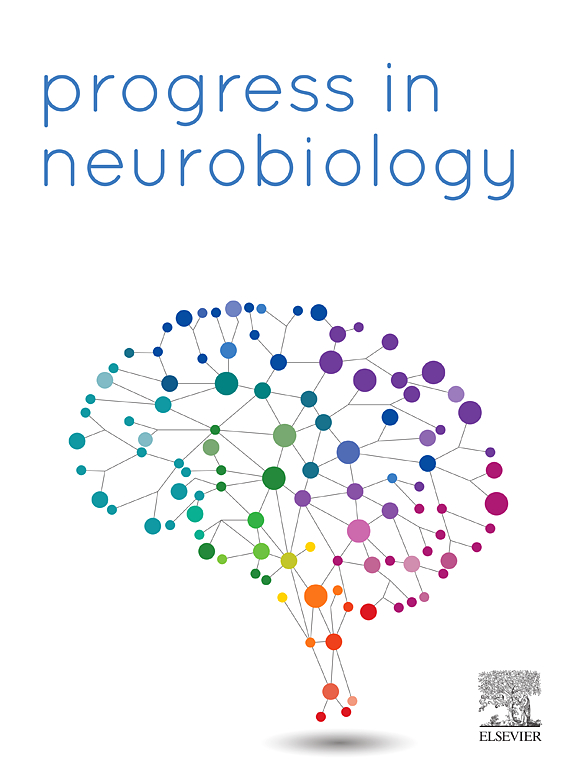运动前皮层兴奋性的调节减轻了帕金森病小鼠模型的行为和电生理异常
IF 6.1
2区 医学
Q1 NEUROSCIENCES
引用次数: 0
摘要
丘脑下核(STN)在抑制性早熟反应倾向中起重要作用。在停止信号反应期间,支配STN的前额叶区域表现出增加的活性,并且这些神经元的光遗传激活抑制了正在进行的行为。高频电刺激STN有效治疗帕金森病(PD)的运动症状,但其潜在的电路机制尚不清楚。在此,我们研究了PD小鼠模型中STN投射前运动(M2)神经元的参与以及针对STN的脑深部刺激(DBS-STN)的影响。我们发现,在PD小鼠模型中,M2神经元表现出增强的突发放电和同步振荡。值得注意的是,模拟DBS-STN过程中反向激活的stn投射M2神经元的高频刺激可缓解运动症状和高兴奋性。这些变化归因于通过标准化超极化激活的内向电流(Ih)降低了放电频率与电流的关系。PD模型小鼠M2神经元Ih升高,高频刺激可逆转Ih升高。此外,将HCN通道阻滞剂ZD7288注入M2可复制高频刺激的效果。总之,我们的研究揭示了PD小鼠模型通过M2-STN突触过度兴奋性和抑制性运动控制。DBS-STN时M2神经元的反向兴奋可缓解这种抑制,从而改善运动损伤。这些发现为深部脑刺激对PD治疗作用的回路水平动力学提供了见解,表明M2-STN突触可以作为未来治疗策略的潜在靶点。本文章由计算机程序翻译,如有差异,请以英文原文为准。
Modulation of premotor cortex excitability mitigates the behavioral and electrophysiological abnormalities in a Parkinson's disease mouse model
The subthalamic nucleus (STN) plays a crucial role in suppressing prepotent response tendency. The prefrontal regions innervating the STN exhibit increased activity during the stop-signal responses, and the optogenetic activation of these neurons suppresses ongoing behavior. High-frequency electrical stimulation of the STN effectively treats the motor symptoms of Parkinson's disease (PD), yet its underlying circuit mechanisms remain unclear. Here, we investigated the involvement of STN-projecting premotor (M2) neurons in PD mouse models and the impact of deep brain stimulation targeting the STN (DBS-STN). We found that the M2 neurons exhibited enhanced burst firing and synchronous oscillations in the PD mouse model. Remarkably, high-frequency stimulation of STN-projecting M2 neurons, simulating antidromic activation during DBS-STN relieved motor symptoms and hyperexcitability. These changes were attributed to reduced firing frequency vs. current relationship through normalized hyperpolarization-activated inward current (Ih). The M2 neurons in the PD model mouse displayed increased Ih, which was reversed by high-frequency stimulation. Additionally, the infusion of ZD7288, an HCN channel blocker, into the M2 replicated the effects of high-frequency stimulation. In conclusion, our study reveals excessive excitability and suppressive motor control through M2-STN synapses in a PD mouse model. Antidromic excitation of M2 neurons during DBS-STN alleviates this suppression, thereby improving motor impairment. These findings provide insights into the circuit-level dynamics underlying deep brain stimulation's therapeutic effects in PD, suggesting that M2-STN synapses could serve as potential targets for future therapeutic strategies.
求助全文
通过发布文献求助,成功后即可免费获取论文全文。
去求助
来源期刊

Progress in Neurobiology
医学-神经科学
CiteScore
12.80
自引率
1.50%
发文量
107
审稿时长
33 days
期刊介绍:
Progress in Neurobiology is an international journal that publishes groundbreaking original research, comprehensive review articles and opinion pieces written by leading researchers. The journal welcomes contributions from the broad field of neuroscience that apply neurophysiological, biochemical, pharmacological, molecular biological, anatomical, computational and behavioral analyses to problems of molecular, cellular, developmental, systems, and clinical neuroscience.
 求助内容:
求助内容: 应助结果提醒方式:
应助结果提醒方式:


